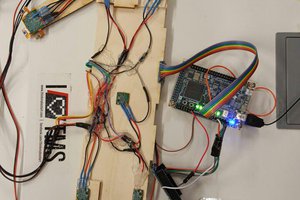1. Prototypes
1.1 IoT design w/ capacitive probe
1.2 Visual control w/ capacitive probe
1.3 Visual control w/ resistive probe
2. Soil moisture sensors
Either one of the following sensor types can be used for the moisture measurement (sensor output here connected to ADC0/GP26):
- Capacitive type sensor HW-390 (also referred to as v2.0)
- Resistive type sensor ME110
An initialization routine identifies the connected sensor type (see MicroPython code in my github repo). The capacitive probe should be preferred though since that is the durable sensor that won't corrode - the anode metal of the ME110 will have vanished after a few hours of operation.
3. Humidity sensor
Prototypes are also utilized for relative humidity measurements with HIH 4020 sensor (7-Segment-Display as well as IoT version). Parts of the already created algorithm had to be enhanced and modified for this obviously (see links to my github repo).
A basic output in a web browser (as to the light sensor, see project log):

Note: there are some robustness measures for the webserver in place, such as using the HW watchdog and using a port different from standard http port 80 (that is dealing with a lot of useless data and requests what may generate confusion in an algorithm).
4. 7-Segment-Displays
I am using three different variants of common cathode 7-Segment-Displays which have slightly different electrical characteristics (they're identical in regards to geometry):
- SC56-11GWA: green
- SC56-11EWA: red
- SC56-11YWA: yellow (those I personally like the most)
This means more precisely that red LEDs have the lowest threshold voltage, green LEDS the highest (keeping in mind the statistical dispersion with individual LEDs).
Notes:
1. Though the ADC of the Pico has some problems (see RP2040 documentation), it is surely good enough for this kind of application.
2. Driving the segments (i. e. LEDs) of the 7-Segment-Displays directly is probably not good an idea since one individual Pico GPIO can deliver 12 mA at most, and it is unclear what the Pico's supply current upper limit is (on all its GPIOs combined). The documentation states something about 50mA, what is clearly not enough to drive a lot of segments at once.
3. The CD4511BE driver has a V_BE voltage drop (see data sheet), and so have the multiplexing transistors. That leads to a diminished voltage budget for the segment LEDs and the resistors R1-R7, respectively, what must be taken into account when calculating the resistor values.
 Florian Wilhelm Dirnberger
Florian Wilhelm Dirnberger




 oneohm
oneohm
 Ryan Gass
Ryan Gass
 Simon Trendel
Simon Trendel
 Boris Landoni
Boris Landoni